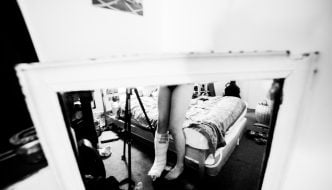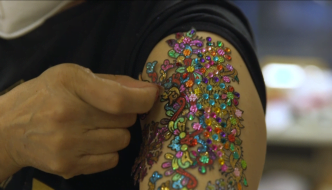Lygia Clark – Organic Planes @ Henry Moore Institute
December 22, 2014
Gallery 4 at the Henry Moore Institute is currently the only space open to the public while the remaining gallery spaces are being refurbished. As you enter the bijoux gallery 4 it feels like you have entered an artist’s studio where the artist- Brazilian Lygia Clark- has just popped out, leaving her studio assistant (the invigilator) seated in the corner. Inside the ‘studio’ we find her Organic Planes project which can be seen in all its glory, described as “a set of actions, articulations and interventions that increasingly involved the body”. This is part of the Bichos series, an affectionate Portuguese word meaning ‘bugs’ or ‘creepy crawlies’.
There are a series of accompanying works alongside the main sculpture including cardboard collages and maquettes in aluminium and balsa wood which give us an insight into Lygia Clark’s thought process as well as her working processes. The collages show the start of the Plane project in two dimensions and take it through to three dimensions in the small maquettes and the centrally placed final sculpture. We have a real sense of the way Lygia Clark worked as an artist. Her processes involved working and reworking the materials, endlessly folding and unfolding paper, cardboard and metal.
The main sculpture is the star of the show, a substanitial and impressive metal piece entitled ‘Bicho pássaro do espaço’ which is translated as ‘creature passing through space’ but as a Portuguese speaker I know that ‘pássaro’ is the Portuguese for bird and has little to do with passing. So it actually translates as ‘bird bug in space’, which makes more sense when you look at the sculpture that appears to have wings as the metal planes are hinged. The hinges in between the planes act as a backbone on the bug or bicho, giving lots of movement to the structure, just like bugs have. The hinges were originally there to be manipulated. Her pieces are made with the intention of being touched and interacted with. She never intended the sculptures to be static pieces that were ‘finished objects’. She intended the relationship between the artist and the viewer to be an ongoing one. As viewers she intended us to explore the possibilities of her works by manipulating them, literally handling the works.
‘[Clark’s] pieces are made with the intention of being touched and interacted with…’
The touch and texture of her work is of great importance to her, as is the relationship that she and her work create with the audience. The pieces are created not just to be perceived from an aesthetic viewpoint but to be actively interacted with. However that is no longer possible. So rather than being interacted with physically, as we are unable to touch the work, we have to use our imagination. The sculpture itself is somewhat tantalising and if the invigilator had not been present I do not trust that I could have kept my hands off the work, which is a true testament to Lygia Clark’s intentions as an artist.
Lygia Clark’s ‘Organic Planes’ is at the Henry Moore Institute until 4th January 2015. For more information and christmas opening hours visit the website – henry-moore.org
Madeleine Walton




Comments